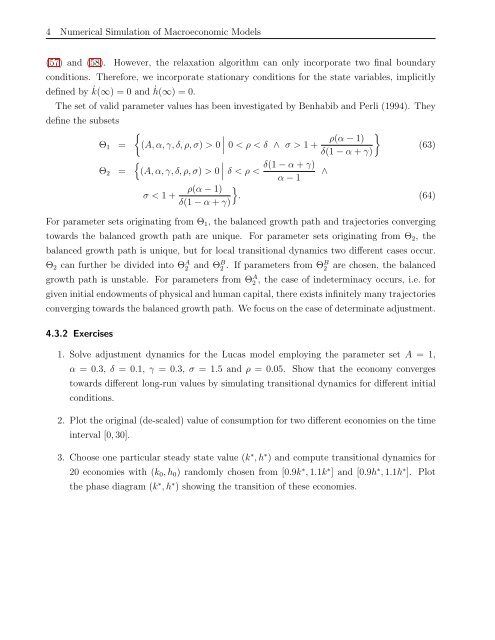Dynamic Macroeconomic Modeling with Matlab
Dynamic Macroeconomic Modeling with Matlab
Dynamic Macroeconomic Modeling with Matlab
You also want an ePaper? Increase the reach of your titles
YUMPU automatically turns print PDFs into web optimized ePapers that Google loves.
4 Numerical Simulation of <strong>Macroeconomic</strong> Models<br />
(57) and (58). However, the relaxation algorithm can only incorporate two final boundary<br />
conditions. Therefore, we incorporate stationary conditions for the state variables, implicitly<br />
defined by ˙ k(∞) = 0 and ˙ h(∞) = 0.<br />
The set of valid parameter values has been investigated by Benhabib and Perli (1994). They<br />
define the subsets<br />
Θ1 =<br />
Θ2 =<br />
<br />
<br />
<br />
<br />
ρ(α − 1)<br />
(A,α,γ,δ,ρ,σ) > 0<br />
0 < ρ < δ ∧ σ > 1 + (63)<br />
δ(1 − α + γ)<br />
<br />
<br />
δ(1 − α + γ)<br />
(A,α,γ,δ,ρ,σ) > 0<br />
δ < ρ < ∧<br />
α − 1<br />
ρ(α − 1)<br />
<br />
σ < 1 + . (64)<br />
δ(1 − α + γ)<br />
For parameter sets originating from Θ1, the balanced growth path and trajectories converging<br />
towards the balanced growth path are unique. For parameter sets originating from Θ2, the<br />
balanced growth path is unique, but for local transitional dynamics two different cases occur.<br />
Θ2 can further be divided into Θ A 2 and Θ B 2 . If parameters from Θ B 2 are chosen, the balanced<br />
growth path is unstable. For parameters from Θ A 2 , the case of indeterminacy occurs, i.e. for<br />
given initial endowments of physical and human capital, there exists infinitely many trajectories<br />
converging towards the balanced growth path. We focus on the case of determinate adjustment.<br />
4.3.2 Exercises<br />
1. Solve adjustment dynamics for the Lucas model employing the parameter set A = 1,<br />
α = 0.3, δ = 0.1, γ = 0.3, σ = 1.5 and ρ = 0.05. Show that the economy converges<br />
towards different long-run values by simulating transitional dynamics for different initial<br />
conditions.<br />
2. Plot the original (de-scaled) value of consumption for two different economies on the time<br />
interval [0, 30].<br />
3. Choose one particular steady state value (k ∗ ,h ∗ ) and compute transitional dynamics for<br />
20 economies <strong>with</strong> (k0,h0) randomly chosen from [0.9k ∗ , 1.1k ∗ ] and [0.9h ∗ , 1.1h ∗ ]. Plot<br />
the phase diagram (k ∗ ,h ∗ ) showing the transition of these economies.
















